Mainline Steam
On Saturday, July 22, Gaby and I traveled by rail west from Christchurch along part of the Tranzalpine route to Arthur's Pass. For a few select weekends the train along this route is pulled by a restored steam engine. I read quite a few reviews of how beautiful this particular route is, as it winds its way west through the Rakaia Gorge, and thought the match of great scenery and a nostalgic steam engine were too good to pass up.
I like steam engines. Even from a distance they evoke a connection to a different time period. Not to mention they are very cool: a maze of pipes and valves, a great calliope of sight and sound. They are a marvel of engineering. In New Zealand, as in many parts of the world, steam engines are from a bygone era, replaced by more efficient and powerful diesel electric locomotives.
When New Zealand switched from steam to diesel electric, a group of dedicated souls fought to retain one of the steam engines and press it into service along the Transalpine route. The Transalpine route crosses the country from Christchurch on the east coast to Greymouth on the west coast. Mainline Steam operates day excursions between Christchurch and Arthur's Pass, near the midpoint of the Transalpine route.
From our previous trip along the Transcoastal route, I knew these trains were equipped with an observation car, open to the outside, where passengers could get great, unobstructed views of the passing countryside. I looked forward to seeing the sights along a different section of rail, and knew the steam engine would add a different element to the scene.

Of course, steam engines are powered by... steam! Fuel for early steam engines in New Zealand was provided by coal, found in abundance along the West Coast of the South Island. The boilers have since been converted to oil burners, but the end result is the same: the water heats up enough to boil - creating steam - which is captured and stored in pressure tanks, piped through a myriad of valves into large pistons attached to the drive wheels.
Steam engines (and, I suppose, other types of engines as well) are given a description based upon the number and position of their axles. JB 1236 is referred to as a 4-8-2. Simply stated, the engine has two axles in the front of the engine which are not driven, 4 axles which are driven - the large steam piston is attached to the wheels on the axles to provide "go" power, and finally, these four driven axles are followed by two additional non powered axles. Everything seems to have its own related language. You learn something new everyday :-)
It was a cold and clear morning (the day before we experienced a particularly nasty sou'easter in Christchurch), and we saw the mushroom cloud puffs of steam from the engine as it was moved out of the railyard. Everyone gathered at the end of the station and mustered for a chance to capture an image of the steam engine connecting to the passenger railcars.
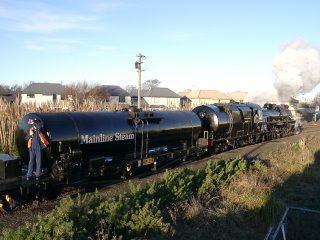
This engine was built in 1939 (J 1236) in the UK and transported to New Zealand the following year. After many years of service a concerted restoration effort was begun in 1998. During the restoration the boiler was converted from a coal burner to an oil burner, and the engine was reclassified as JB 1236.

Steam engines require water and must periodically refill the water tenders. JB1236 is no different, and makes a stop at Springfield to replenish the water supply. I had visions of the train stopping under a large elevated wooden tank equipped with a long metal spout hinged at the bottom, lowered down to hang just above the water tender while someone pulled a cord to turn on the valve and gravity feed the water into the tank.

I took this opportunity to get off the train and take a closer look at the steam engine. My nostalgic visions were destroyed when I watched the steam engine uncouple from the train and cruise down the track. I grabbed my camera and followed.
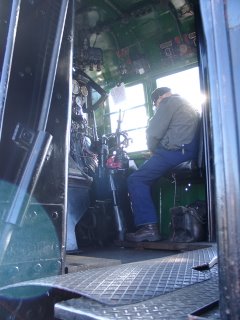
Instead of an elevated water tank, the engine moved down the track and stopped on a bridge over a small river. One of the crew then lowered a hose into the river, started a petrol powered water pump, and proceeded to fill the water tender - so much for my nostalgic vision.

I was able to walk around the engine as the crew worked to fill the water tender. Occasionally bursts of steam would shoot out at odd angles from various places on the engine.

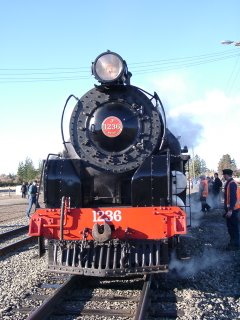
Christchurch is located on the Canterbury Plain, a large coastal plain along the central East Coast of the South Island, a deposit resulting from the intense erosion of the Southern Alps. This area is the bread basket of the South Island - agriculture is prevalent here. Springfield is located at the western extent of the Canterbury Plain, at the base of the Southern Alps.
West from Springfield the rail follows the couse of the Waimakariri River upstream for quite a way. Soon the terrain steepens, and the views are outstanding.
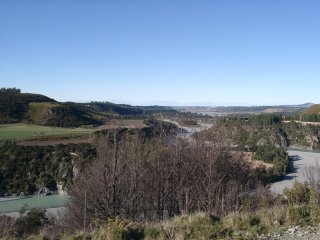
The Southern Alps are steep and the views are spectacular. I grabbed my camera and headed for the observation car, hoping to capture some great pictures. As the railroad grade steepens, the steam engine has to work harder to pull the train along the track. When the engine works harder, more billowing clouds of steam are created. Oh, I forgot to mention the tunnels. The tracks go through many tunnels. There are something like 16 tunnels between Springfield and Arthur's Pass.
Gaby and I happily peered out over the side of the observation cars, gazing out at the scenery. I wanted to get a shot of the train rounding a corner, so I could see the whole train and the engine belching out steam. Very cool. We passed through the first tunnel. It was neat to be within 25 cm from the walls of the tunnel as we sped our way through. The tunnel was short and we quickly emerged back into daylight. The tunnels are also separated by viaducts (that's Kiwi for a bridge :-). It was fun to cross the viaducts and enter yet another tunnel, feeling the wind in your face.

After a few tunnels something finally dawned on me. There is, of course, steam which blasts out of the stack of the engine - this I was fully aware of. What I did not realize however (but something that would have occurred to most average thinking people), is that exhaust (originally soot from burning coal, but now soot and unburned oil) exits the stack along with the steam. This was all well and good and quite attractive when the train was viewed around bends in the track, wending its way through the narrow gorges. However, standing in the open observation car whilst the steam engine pulled the train through the long narrow tunnels was altogether different.
The first short tunnel was not a problem. When the train passed through longer tunnels, the belching exhaust from the engine's stack filled the entire free space withing the tunnel, which inevitably engulfed the open air observation car near the back of the train. At times the oily exhaust was so thick I could not see Gaby standing 1 meter away! We both tried in vain to cover our mouths and breath through our scarves. After the fourth or fifth tunnel we gave up. We made a quick exit back to our seats. That was when we noticed the funny looks.
As we made our way back to our seats people would look at us in an odd way or even snicker. The thick clouds of oily exhaust coated everything in a thin layer of black oily soot - our hair, our clothes, and our faces were coated in it - yuck! After a quick trip to the bathroom I resolved to keep inside the train for the rest of the trip.
We made great progress up the pass, at least while the engine was holding sufficient steam pressure. The old engine had a difficult time keeping a good head of steam and on three different occasions the train had to stop to allow the boiler to "blow up" (generate enough steam pressure to continue up the pass. However, these pauses were a great excuse to get a good look at the surroundings. We eventually made it into the Arthur's Pass station (albeit, 1.5 hours later than scheduled).
The day before our trip a nasty storm rolled over the South Island, dumping 25 cm of fresh snow in Arthur's Pass. The snow was beautiful, even if it was cold. Our original plan was to spend an hour or so relaxing in a restaurant before the train's scheduled departure back to Christchurch; however, since the train arrived 1.5 hours late, we only had 50 minutes before the train was scheduled to depart. We decided to quickly get out of the station and head to a cafe for a quick bite to eat and a hot chocolate.
One of my goals during this trip was to find some keas. Kea are mountain parrots. These are large beautiful birds and very curious animals. I do not usually associate keas and snow. These birds really like attention, and often perform crazy antics so people notice them!

The recent snow entirely covered the tracks in the rail yard, and after we ate lunch, Gaby and I walked back to the station to watch the steam engine head to the round-a-bout for the return trip. It was exciting to watch the engine plow the snow from the tracks as it maneuvered around to the front of the train.



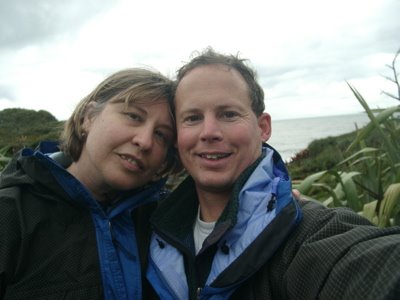

2 Comments:
These might be your best pictures yet! Wonderful post, keep up the good work.
I feel like I'm taking a vacation in New Zealand every time I read your stories. I wish I had more free time to travel. I like trains too, but 25 cm from the tunnel wall sounds nervously close. And even though it's storm season, looks like you picked a great day for the trip.
Post a Comment
<< Home